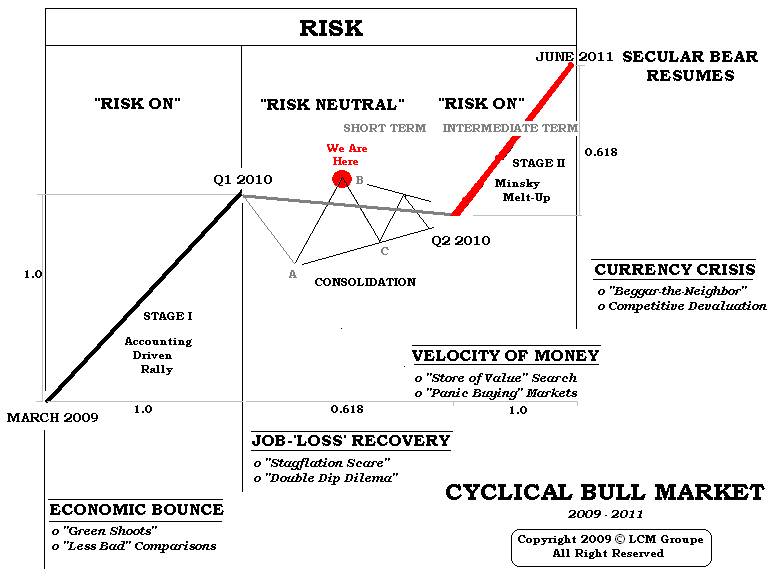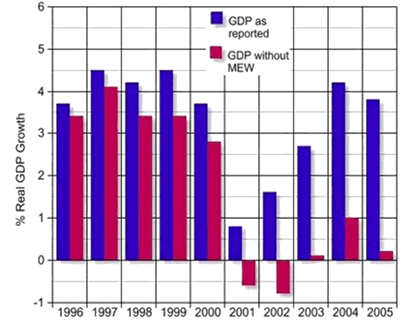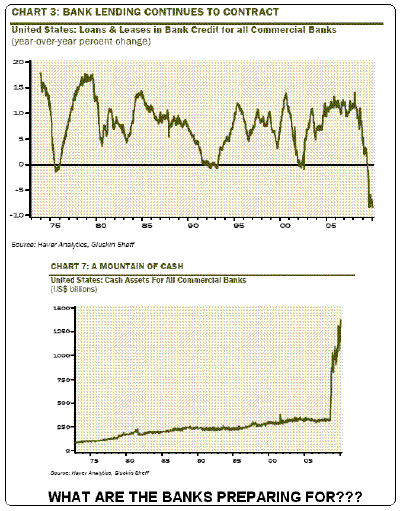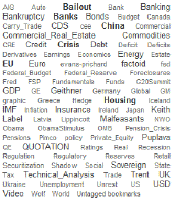EXTEND
& PRETEND:
Manufacturing a Minsky Melt-Up!
A distracted and preoccupied amateur is no match for a determined,
organized professional with a strategy. Though the collapse of the shadow
banking system was a near fatal miscue for the global bankers, they have
been quick to adjust their strategy. With an army of MBAs, quants and
lobbyists they have reworked their strategy at the expense of the still
comatose and shaken taxpayer.
It is the first anniversary since April 2nd when FASB 157 was
suspended and with it the suspension of ‘mark-to market’ accounting. The
US congress held a gun to the head of the Financial Accounting Standards
Board a year ago. Congress left FASB no choice but to change their
guidelines under the perception that it was a deferral allowing time for the
banks to adjust the toxic and devalued assets on their books. Where are we a year
later with Mark-to Market still ‘on hold’ and Mark-to-Myth endorsed by the
Federal Reserve Bank examiners? Frankly, the ‘happy face’ media doesn’t
want to talk about it, so I will. As an investor, unlike politicians and
the media, I must face reality or I will pay the ugly consequences.
In January's
EXTEND & PRETEND - An Accounting Driven Market Recovery,
I outlined the accounting changes that had been implemented to ignite a
market reversal and rally from the March 2009 low. These accounting
changes ranged from the deferral of FASB 157 in March 2009, the Commercial
Real Estate Loan Workout Policy in October 2009, the three cauldrons
easing in November 2009, the deferral of FASB 166 and 167 in December 2009
and the System Wide Federal Bank Examiner Reinforcement Training in
January 2010. The changes were executed in a controlled and almost
militaristic operation. The market has reacted with a
58.4%
retracement of the 2008 decline and a 70%
increase from the lows in the DOW industrial, trumpeted eagerly by the
nightly news. This was Stage I.
Before we discuss Stage II, which will be the manufacturing of a
“Minsky Melt-Up”, let’s briefly review the extent to which Stage I has
created distortions in the accounting of public traded financial
fiduciaries. We will then be able to see clearly how they have created the
launch pad for Stage II.

STAGE I – AN ACCOUNTING
ORCHESTRATED RALLY
The Friday Night Lottery
Almost every Friday night the FDIC seizes from
1 to 5 local or regional banks as insolvent failures. Saturday morning
we wake to find these bankrupt banks have been magically merged with
another bank. It all seems so normal. But does that speed and ease sound
realistic to you?
According
to Karl Denninger at
The Market Ticker who follows these matters very closely, on
March 6th he reported:
I am
constantly amused by those people who claim there is some vast
"conspiracy" in this country when it comes to banks, balance sheets, and
fraudulent lending and accounting. There is no conspiracy. It is, in
fact, "in your face" fraud. The FDIC does us the courtesy of explaining
it virtually every Friday night,
right on their web page. I am simply
going to take last night's bank closures, which numbered four. One of
them has no "deposit insurance fund" estimated loss available, because
they didn't find someone to take the assets - they're just mailing
checks. But the other three do.
1-
Waterford Bank, Germantown MD: $155.6 million in assets, $156.4 in insured deposits. They were
"underwater" by $800,000, right? Wrong: Estimated loss, $51
million. That is, the assets of $155.6 million were overvalued
by approximately 30% at the time of seizure.
2-
Bank of Illinois, Normal IL: $211.7 million in assets, $198.5 million in deposits. They were
"underwater" by $13.2 million (which is why they were seized), right?
Wrong: Estimated loss $53.7 million. That is, the the assets
of $211.7 million were overvalued by more than 25% at the time of
seizure.
3-
Sun American Bank, Boca Raton FL: $535.7
million in assets (so they claimed anyway), $443.5 million in total
deposits. Heh, why did you seize them - they have more assets than
liabilities? Oh wait: Estimated loss: $103.8 million, so the
actual assets are worth $443.5 - $103.8, or $339.7 million. That is,
the assets of $535.7 million were overvalued by a whopping 37% at the
time of seizure.
This
isn't new, by the way.
In August of 2009 I went
through Colonial Bank's failure based on BB&T's presentation to its
shareholders on the "merger" - and gift it was given by the FDIC. It
too showed that Colonial had been carrying assets on their books at a
ridiculous 37% above where BB&T ultimately marked them as a
whole.
Folks,
your bank is being assessed deposit insurance premiums to pay for these
losses. You are paying these losses through increased
fees and interest expense on your credit cards and all other manner of
borrowing. You are paying for outrageous, pernicious and endemic
balance sheet fraud. There is no conspiracy. It is right under your
nose. One of these three banks, based on their balance sheet, wasn't
even underwater - it was "to the good" by nearly $100 million dollars.
The balance sheet was a flat, bald-faced lie. You want to sit for
this? Why should you?
Now
let's ask the inconvenient question:
Are the
big banks - specifically, Citibank, Bank of America, Wells Fargo and JP
Morgan - all similarly overvaluing their assets?
Why
should we believe they are not? You can go through more than a year's
worth of FDIC bank seizure information and in essentially every
single case you will find that overvaluations of somewhere from
20-50% have in fact occurred, yet not one indictment for
book-cooking has issued.
So let's
be generous and assume that the "big banks" are over-valuing their
assets by 25% - the lower end of the range of what the FDIC says is,
through actual experience, what's going on, and add it all up.
Bank of America shows $2.25
trillion in assets.
Citibank shows $1.89 trillion in
assets.
JP Morgan/Chase shows $2.04
trillion in assets.
Wells Fargo shows $1.31 trillion in
assets.
This
totals $7.49 trillion smackers.
The
FDIC's experience with seizing banks thus far suggests quite strongly
that all four of these entities are lying about these valuations, and
that were they to be seized the loss embedded in them (and for which
you, the taxpayer would be responsible) is somewhere
between $1.49 and $2.99 trillion dollars.
Incidentally, neither the FDIC or Treasury happens to have either
$1.49 or $2.99 trillion laying around, and it is highly questionable if
they could raise it, should that become necessary. Now of course neither you or I can prove this is correct.
However, we can look at the FDIC's own published bank closing
statements, and derive from them a pattern stretching back more than a
year now that has disclosed that in essentially each and every
case the banks in question have overvalued their assets by
anywhere from 20-40%, and that as of the day of the seizure
such an overvaluation was in fact a continuing and ongoing practice. (1)
This was precisely what was in the process of happening, as I
outlined in
EXTEND & PRETEND - An Accounting Driven Market Recovery.
If you were a bank, why would you lend to small business or the consumer
with their inherent risks when you could play the Friday Night Lottery? As
A bank CEO you would ensure that you have plenty of cash ready to buy and take
over the depositors (whose assets you desperately need), while having most
of the bad debt written off and then likely getting very favorable FDIC
guarantees for quickly taking the banks off FDIC’s highly depleted balance
sheets. I imagine every US bank CEO & his/her Board of Directors watch these results closer than the March Madness basketball rankings!
To facilitate these bankrupt banks being taken over so quickly, there is
obviously a considerable amount of very secret negotiations (non transparent, non public bidding) taking place behind the scenes.
Like we saw with TARP (Troubled Asset Relief Program), it is amazing how
much money gets spilled when everyone is in a frenzy to feed at the
government trough.
It’s Only
Going to Get Worse
The
biggest financial issue with local and regional banks is their commercial
real estate loans with building and construction loans being the worst.
The official government stance as stated in the
February report from the Congressional
Oversight Panel makes for sobering reading. It forecasts $200
to $300 billion in losses coming from commercial real estate (CRE) loans. The
report notes these were not considered in the famed stress tests, since
that process looked only through 2010, when the losses from CRE will peak
later. It outlines that:
-
Between 2010 and 2014, about
$1.4 trillion in commercial real estate loans will reach the end of
their terms. Nearly half are are presently underwater, that is the
borrower owes more than the underlying property is currently worth.
-
Commercial property values have
fallen more than 40 percent since the beginning of 2007.
-
Increased vacancy rates, which
now range from 8 percent for multifamily housing to 18 percent for
office buildings, and falling rents, which have declined 40 percent for
office space and 33 percent for retail space, have exerted a powerful
downward pressure on the value of commercial properties.
-
The largest commercial real
estate loan losses are projected for 2011 and beyond; losses at banks
alone could range as high as $200-$300 billion.
-
The stress tests conducted last
year for 19 major financial institutions examined their capital reserves
only through the end of 2010. Even more significantly, small and
mid-sized banks were never subjected to any exercise comparable to the
stress tests, despite the fact that small and mid-sized banks are
proportionately even more exposed than their larger counterparts to
commercial real estate loan losses.
-
A significant wave of
commercial mortgage defaults would trigger economic damage that could
touch the lives of nearly every American.
-
Empty office complexes, hotels,
and retail stores could lead directly to lost jobs. Foreclosures on
apartment complexes could push families out of their residences, even if
they had never missed a rent payment. Banks that suffer, or are afraid
of suffering, commercial mortgage losses could grow even more reluctant
to lend, which could in turn further reduce access to credit for more
businesses and families and accelerate a negative economic cycle.
-
It is difficult to predict
either the number of foreclosures to come or who will be most
immediately affected. In the worst case scenario, hundreds more
community and mid-sized banks could face insolvency. Because these banks
play a critical role in financing the small businesses that could help
the American economy create new jobs, their widespread failure could
disrupt local communities, undermine the economic recovery, and extend
an already painful recession.
The
Chair of the Congressional Oversight Panel, Elizabeth Warren, in
an interview with Charlie Rose on NPR stated:
CHARLIE
ROSE: Commercial real estate, what are we looking at.
ELIZABETH WARREN: Oh golly -- 2,988 banks that by the terms of their
own regulators are too concentrated in commercial real estate. These
are the medium size banks. By the end of this year, half of all
commercial real estate loans will be underwater, and they are coming in
‘11, ‘12 and ‘13.
The reason this is such a bad problem anyway -- think about that, nearly
3,000 banks out of a total of 8,000 -- it’s the very banks that do
small business lending who are about to get socked in the nose on real
estate, commercial real estate losses.
CHARLIE ROSE: So we’ll see banks going under because they’ve got too
many loans out there are not being repaid?
ELIZABETH WARREN: We’re seeing banks that don’t want to lend because
they see every dollar that comes in the door and say "I’ve got to hold
on to it to try to fill my commercial real estate hole or else I will be
gone."
Home Equity Loans (HELOCS)
I find it amazing that with all the talk about government programs to keep
people in their foreclosed homes, with government incentives to increase
home sales, with new home construction at a near standstill and home
prices finally reaching some sort of bottom (near term), we never talk
about the billions of Home Equity Loans that were taken out from 1996
onward. Does it pass your common sense test that people would stop
paying their mortgage, car payments, credit cards and yet still pay their
Home Equity Loan? I don’t think so. But the banks have written down next
to nothing here. This is the issue with Mortgage write-down. If you write
down the mortgage, by definition the Home Equity Loan is now a 100%
write-off. Ouch! Doesn’t anyone remember this graph which was so prevalent
only a few years ago?

This is an absolute huge problem and is presently being hidden behind
all the mortgage foreclosure coverage. Amherst Securities, according to
Reuters " has said "commercial banks hold approximately $767 billion
of the total $1.05 Trillion of second mortgages outstanding, with the Big
4 holding over $400 billion alone."
Reuters
estimates that if the banks mark down the entire portion of home equity
debt that exceeds home value values, the net of estimated reserves would
be:
$37.2 billion for Wells Fargo
$29.9 billion for JP Morgan
$28.6 billion for Bank of
America
$11.5 billion for Citi
=====
$107.2 billion
If we were to write down these unsecured home equity lines by only 40%,
then the potential increase in regulatory capital for these 4 banks
increases by: $3.1B for Wells Fargo, $1.3B for JP Morgan, $2.1B for Bank
of America and $1.0B for Citigroup. Nothing is
being done, nor is anything being forced by Federal Reserve Bank examiners
to be done.
I could go on about shadow housing inventory, ‘jingle’ mail and ‘strategic
defaults’, the python in the pipe with Option-ARMS, the failure of HAMP
etc., but I am sure you have heard all you want to hear about housing to
know the banks have yet to effectively address the issue. Like landmines
the issues still lay on their balance sheets.
Because of
this situation,
the banks still minimally
require
40% higher collateral values. So how are they going to get it?
STAGE II --
MANUFACTURING A MINSKY MELT-UP
 My
grandfather, who was proud to keep his farm during the depression, had an
expression that I haven’t heard in a long time. He was fond of warning that:
“Banks lend you an umbrella when it is sunny and then demand it back when
it starts to rain!” It has been a long time since we have had a ‘rainy’
economy for any protracted period of time, but to this prairie farm boy
the economic weather forecast doesn’t look that good.
My
grandfather, who was proud to keep his farm during the depression, had an
expression that I haven’t heard in a long time. He was fond of warning that:
“Banks lend you an umbrella when it is sunny and then demand it back when
it starts to rain!” It has been a long time since we have had a ‘rainy’
economy for any protracted period of time, but to this prairie farm boy
the economic weather forecast doesn’t look that good.
We therefore need to remember some basics of banking. First, banks make
money borrowing short and lending long. This strategy is inherently risky.
This is why banking requires extensive regulatory laws and ever vigilant
bank examiners. Neither are to be ‘tampered’ with, which our politicians
now seem oblivious to.
Secondly, inflation and deflation are different for banks. The Consumer
Price Index and how much food, energy, consumer staples etc have increased
is not highly relevant to banks. Inflation or deflation to banks is about
asset price increases or decreases. It is about whether their collateral
positions are increasing or decreasing. I don’t mean to be too simplistic
here since cost of money is critically important, but it serves to make
the point that bank strategy is driven by their view of the direction of
asset prices and whether their loans are covered, their capital ratio
requirements are secure or what a new risk adjusted loan is worth to them.
What does this chart to the right say about where banks view asset prices
to be headed?
Banks win
on asset inflation. Banks potentially lose on asset deflation.
Rising
asset prices:
1- Make
Collateral more valuable or easier to secure for banks
2- Raise
borrowing levels with which to finance higher priced asset prices which
increase interest payments and fees.
If banks thought collateral values were headed lower, here is what they
would do:
|
1-
Freeze new loans secured by collateral that will potentially
deflate |
In
Process |
|
2-
Seize existing loan collateral on defaulted loans before collateral
falls below book value |
In
Process |
|
3-
Demand higher collateral levels for loans |
In
Process |
|
4-
Charge higher rates and tighter terms |
In
Process |
Banks need asset values to continue to climb. Now that the markets have
reached ‘nose bleed’ levels and appear to be at the stage of looking for a
consolidation, the banks need another strategy to ignite asset prices
further. The banks must see higher asset prices to have any hope of
achieving satisfactory Capital Ratios with the known amounts of bad and
toxic debt still on their books. Is it any wonder banks are now making
their profits primarily in their trading operations driving asset prices
higher and with their Interest Swap where they are squeezing collateral
call levels? (see:
SULTANS OF SWAP: The Get
Away!)
MANUFACTURING A MINKSY MELT –UP
If the banks wanted to get collateral values up, and manufacture a ‘Minsky
Melt-Up' here is what some of their strategy elements would call for:
I am not saying that a successful Minsky Melt-Up will be achieved or in
fact could be successfully manufactured. Frankly, I would be very skeptical
if it weren’t for the fact that former Federal Reserve Chairman Alan
Greenspan specifically said this could not happen (He also stated that
market bubbles could not be identified by the Fed nor addressed with
Monetary Policy (yeh right)). His views
have typically been my contrarian indicator which has given me an
investment edge over the years.
Before reading Alan Greenspan’s ‘Greenspeak’, consider that we presently have
unstable economic policies, risk premiums have been high and the Fed has
successfully inflated a bubble in the Bond Market over the last 20 months
through QE (Quantitative Easing).
…Greenspan said
“because the markets themselves are asymmetric: they melt down, but
don’t melt up!” Mr. Greenspan argues:
(1) the ironic result of successful stabilization policies is a journey
to excessively-thin risk premiums, and if
(2) history has not dealt kindly with the aftermath of protracted
periods of low risk premiums, and if
(3) asset prices do not tend to melt up but do tend to melt down,
then
(4) logic implies that the fattest fat-tailed secular risk to price
stability is deflation, not inflation.
How so? If bubbles are the ironic externality of successful
stabilization policies, then those policies can be successful only so
long as there are asset classes that the central bank can inflate into a
bubble. When there are no more free and clear assets to lever up, the
game ends in a debt-deflation. As the great Hyman Minsky intoned,
stability is ultimately destabilizing! That is the logical consequence
of too-successful inflation stabilization. Don’t call it a conundrum,
but rather a dilemma, if the Fed were to set and achieve a too-narrow
target zone for inflation. (2)
If according to Hyman Minsky, protracted periods of market stability leads
to instability and a market meltdown, does this preclude therefore that
protracted periods of market instability negate the possibility of a
market melt-up (per Greenspan)? I intentionally phrased the logic
for this argument in perfect ‘Greenspeak’ fashion so we can all remember
exactly how we got ourselves into this global predicament in the first
place.
CONCLUSION
This is a
well executed strategy. It has been almost militaristic in its execution -
all the elements from a solid communications program (i.e. CNBS hype),
accounting and regulatory changes (FASB 157, 166, 167 deferrals et al ),
government statistics (does anyone actually still believe the CPI, Labor
Report or other
government statistics
any more?), and public’s sentiment through the controlled market
perception barometer pumped at them every evening on how well the DOW
Industrials are doing. The US economic and financial situation has now
reached a point where the potential crisis could be referred to by our
government interventionists as a matter of national security. This is
precisely why I am leaning towards a Minsky Melt-Up being successfully
manufactured.
There is an old market saying: “Don’t fight the Fed!” This market
guideline has never been truer. In fact today it is more appropriate to
say:
“It is impossible to fight central bank planning”
To fight the central party planning (i.e. shorting an artificial market)
exposes your wealth to being officially confiscated!
Sounds like something
Karl Marx would have said?

Sign Up for the next release in the
Extend & Pretend series:
Commentary
SOURCES:
(1)
03-06-10
All
You Need To Know About Bank Balance-Sheet Fraud
The Market Ticker
(2) 08-03-06
Paul McCulley and Doug Noland Both Praise Hyman Minsky
Economic Dreams
(3) 04-06-10
New NYSE Options Pricing Pyramid Promotes Derivative Driven
Market Melt-Up Zero Hedge
(4) 04-08-10
Home equity horror
Reuters
The last Extend & Pretend article:
EXTEND & PRETEND - Hitting the Maturity Wall!
Gordon T Long
Tipping Points
Mr. Long is a former senior group executive with IBM & Motorola, a
principle in a high tech public start-up and founder of a private venture
capital fund. He is presently involved in private equity placements
internationally along with proprietary trading involving the development &
application of Chaos Theory and Mandelbrot Generator algorithms.
Gordon T Long is not a registered advisor and does not give investment
advice. His comments are an expression of opinion only and should not be
construed in any manner whatsoever as recommendations to buy or sell a
stock, option, future, bond, commodity or any other financial instrument
at any time. While he believes his statements to be true, they always
depend on the reliability of his own credible sources. Of course, he
recommends that you consult with a qualified investment advisor, one
licensed by appropriate regulatory agencies in your legal jurisdiction,
before making any investment decisions, and barring that, you are
encouraged to confirm the facts on your own before making important
investment commitments.
© Copyright 2010 Gordon T Long. The information herein was obtained from
sources which Mr. Long believes reliable, but he does not guarantee its
accuracy. None of the information, advertisements, website links, or any
opinions expressed constitutes a solicitation of the purchase or sale of
any securities or commodities. Please note that Mr. Long may already have
invested or may from time to time invest in securities that are
recommended or otherwise covered on this website. Mr. Long does not intend
to disclose the extent of any current holdings or future transactions with
respect to any particular security. You should consider this possibility
before investing in any security based upon statements and information
contained in any report, post, comment or recommendation you receive from
him.










